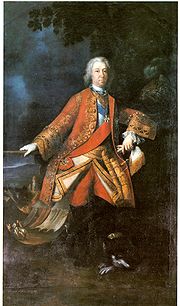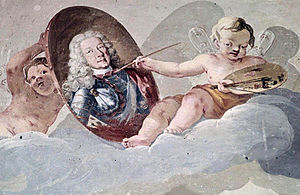
Eberhard Ludwig
Encyclopedia


Württemberg
Württemberg , formerly known as Wirtemberg or Wurtemberg, is an area and a former state in southwestern Germany, including parts of the regions Swabia and Franconia....
, from 1692 until 1733.
Biography
Eberhard Louis was born in StuttgartStuttgart
Stuttgart is the capital of the state of Baden-Württemberg in southern Germany. The sixth-largest city in Germany, Stuttgart has a population of 600,038 while the metropolitan area has a population of 5.3 million ....
the third child of Duke William Louis
Wilhelm Ludwig, Duke of Württemberg
William Louis of Württemberg was the ruler of the senior Duchy of Württemberg from 1674 until his death in 1677....
and his wife, Magdalena Sibylla of Hesse-Darmstadt
Magdalena Sibylla of Hesse-Darmstadt
Landgravine Magdalena Sibylla of Hesse-Darmstadt was regent of the Duchy of Württemberg from 1677 to 1693, and was a prominent German composer of baroque hymns.- Life :...
. After the early and unexpected death of his father in 1677, the royal court decided to give guardianship to his uncle, Frederick Charles, Duke of Württemberg-Winnental.
In 1693, Magdalena Sibylla had the 16-year-old Eberhard Louis prematurely proclaimed Duke of Württemberg by Emperor Leopold I
Leopold I, Holy Roman Emperor
| style="float:right;" | Leopold I was a Holy Roman Emperor, King of Hungary and King of Bohemia. A member of the Habsburg family, he was the second son of Emperor Ferdinand III and his first wife, Maria Anna of Spain. His maternal grandparents were Philip III of Spain and Margaret of Austria...
. The young duke showed no excessive interest in governmental affairs. Eberhard Ludwig was described by his contemporaries as superficial and easily influenced. Most importantly, his behavior led to the political fate of the land being greatly decided by his council. The duke preferred hunting and left the administration of his county in the hands his advisors. In 1697, he married Joanna Elisabeth of Baden-Durlach
Joanna Elisabeth of Baden-Durlach
Johanna Elisabeth of Baden-Durlach , was by marriage Duchess of Württemberg.-Marriage:Johanna of Baden-Durlach was born in the Karlsberg, Durlach, the third child of Friedrich VII Magnus, Margrave of Baden-Durlach and his wife Auguste Marie of Holstein-Gottorp .In 1697 she was married in a...
.
In 1707 he became the field marshal of the Swabia
Swabia
Swabia is a cultural, historic and linguistic region in southwestern Germany.-Geography:Like many cultural regions of Europe, Swabia's borders are not clearly defined...
n troops in the War of the Spanish Succession
War of the Spanish Succession
The War of the Spanish Succession was fought among several European powers, including a divided Spain, over the possible unification of the Kingdoms of Spain and France under one Bourbon monarch. As France and Spain were among the most powerful states of Europe, such a unification would have...
.
Shortly before 1700, he visited Louis XIV of France
Louis XIV of France
Louis XIV , known as Louis the Great or the Sun King , was a Bourbon monarch who ruled as King of France and Navarre. His reign, from 1643 to his death in 1715, began at the age of four and lasted seventy-two years, three months, and eighteen days...
at the Palace of Versailles
Palace of Versailles
The Palace of Versailles , or simply Versailles, is a royal château in Versailles in the Île-de-France region of France. In French it is the Château de Versailles....
and planned to make an absolutist state out of Württemberg. He raised taxes, but financing still remained an obstacle. In 1704, he laid the foundation for his Ludwigsburg Palace
Ludwigsburg Palace
Ludwigsburg Palace is a historical building in the city of Ludwigsburg , Germany. It is one of the country's largest Baroque palaces and features an enormous garden in that style....
. To save money, he allowed the workers to reside tax-free around the palace for 15 years. Later, the city of Ludwigsburg
Ludwigsburg
Ludwigsburg is a city in Baden-Württemberg, Germany, about north of Stuttgart city centre, near the river Neckar. It is the largest and primary city of the Ludwigsburg urban district with about 87,000 inhabitants...
developed out of these residences.
As of 1711, Eberhard Louis spent ever more time in Ludwigsburg, usually in the company of his mistress, Wilhelmine von Grävenitz
Wilhelmine von Grävenitz
Wilhelmine von Grävenitz was a German noble, the favorite and royal mistress of Duke Eberhard Ludwig of Württemberg between 1706 and 1731....
, whom he married in 1707. Because of pressure from the emperor, the marriage had to be quickly dissolved, and Grävenitz went into exile. Eberhard Louis followed her to Switzerland
Switzerland
Switzerland name of one of the Swiss cantons. ; ; ; or ), in its full name the Swiss Confederation , is a federal republic consisting of 26 cantons, with Bern as the seat of the federal authorities. The country is situated in Western Europe,Or Central Europe depending on the definition....
, where they stayed until 1710. The influential mistress was only allowed to return to the royal court once she had married another man, Graf von Würben. For over two decades, Grävenitz had a strong influence on the government of the land, and it was she who, together with Eberhard Ludwig, moved the royal residence and capital of the duchy from Stuttgart to the sparsely populated city of Ludwigsburg. Duchess Joanna Elisabeth von Baden Durlach stayed in the royal palace in Stuttgart.
Because of the early death of his heir, Prince Frederick Louis, in 1731, the power threatened to shift into Catholic hands, which was unthinkable for Protestant Württemberg. Thus Duke Eberhard Louis dissolved his relations with Wilhelmine von Grävenitz and hoped to receive an heir from his legitimate and long ignored wife, Joanna Elisabeth. However, as he died in Ludwigsburg of a stroke
Stroke
A stroke, previously known medically as a cerebrovascular accident , is the rapidly developing loss of brain function due to disturbance in the blood supply to the brain. This can be due to ischemia caused by blockage , or a hemorrhage...
on October 31, 1733, he left no heir behind. The duchy then fell into the hands of his converted nephew, Charles Alexander, Duke of Württemberg of the bloodline Württemberg-Winnental, though only for a few years.

